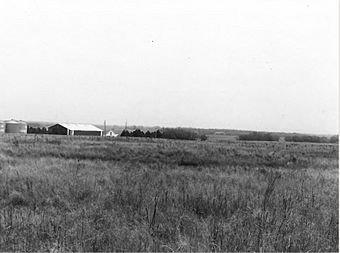Tobias-Thompson Complex facts for kids
|
Tobias-Thompson Complex
|
|

1975 Park Service photo of the Tobias site council circle
|
|
| Lua error in Module:Location_map at line 420: attempt to index field 'wikibase' (a nil value). | |
| Nearest city | Geneseo, Kansas |
|---|---|
| NRHP reference No. | 66000349 |
Quick facts for kids Significant dates |
|
| Added to NRHP | October 15, 1966 |
| Designated NHLD | July 4, 1964 |
The Tobias-Thompson Complex, also called the Little River Archeological District, is a group of important ancient sites. These sites are found along the Little Arkansas River near Geneseo, Kansas, in the United States. They are special because they show us what life was like between the years 1500 and 1700 CE. This was a time when Native American cultures were still thriving, just before or as they first met Europeans. Because of its historical value, the complex was named a National Historic Landmark in 1964. It was also added to the National Register of Historic Places in 1966.
Contents
What is the Tobias-Thompson Complex?
The Tobias-Thompson Complex includes eight different archaeological sites. These sites are located on both sides of the Little Arkansas River. Experts believe they were all part of one very large settlement area. This big area was likely divided into several smaller villages.
Exploring the Ancient Villages
Because of where these sites are located, some historians think this might be a village that the Spanish explorer Francisco Vázquez de Coronado visited. He explored this area in 1541. Coronado was looking for a place he called Quivira.
Typical features found at these sites include special areas called council circles. These were likely gathering places for important meetings. There are also sunken areas in the ground. These dips show where homes once stood. These homes were often partly underground. Other mounds found are believed to be places where food was stored. Some mounds might also be ancient trash piles, called middens.
Discovering Artifacts and History
Over time, some of these sites have lost artifacts from the surface. This happened because the land was used for farming. However, other parts of the complex have never been farmed. These areas are still covered by natural grass. This means many artifacts might still be hidden there.
Sadly, some of these sites have been known for a long time. This led to people illegally digging up artifacts, which is called looting. Even with this, the complex is so large that there is still much to learn. Scientists believe many important clues about the past are waiting to be found.
Archaeological Digs at the Tobias Site
The Tobias site is one of the most important parts of the complex. It has been excavated, or carefully dug up, three times. The famous archaeologist Waldo Rudolph Wedel led these digs. He worked for the Smithsonian Institution. His excavations took place in 1940, 1965, and 1971.
Important Discoveries by Waldo Wedel
The excavation in 1965 was especially important. During this dig, archaeologists found something amazing. They discovered evidence of an even older living area. This older layer was hidden deep beneath the site's council circle.
The things found during these investigations tell us a lot about the people who lived there. They include pieces of pottery, tools made from stone and bone, and sharp points used on spears or arrows. Human remains were also found, giving us clues about the ancient inhabitants.

